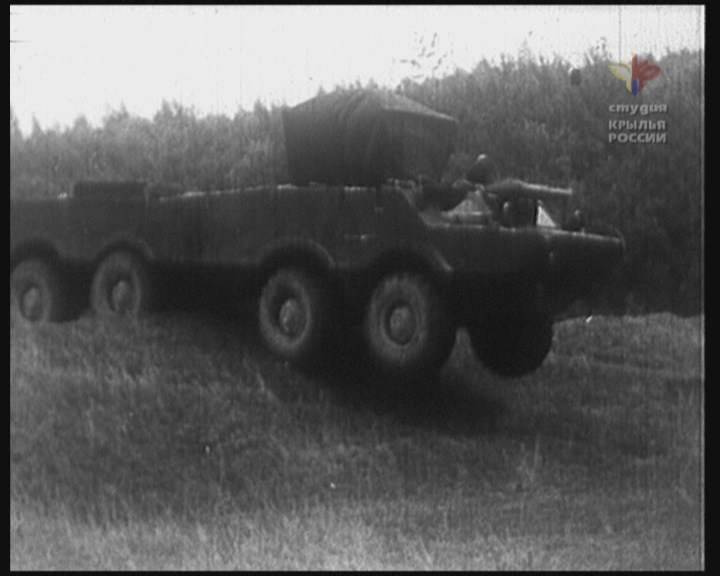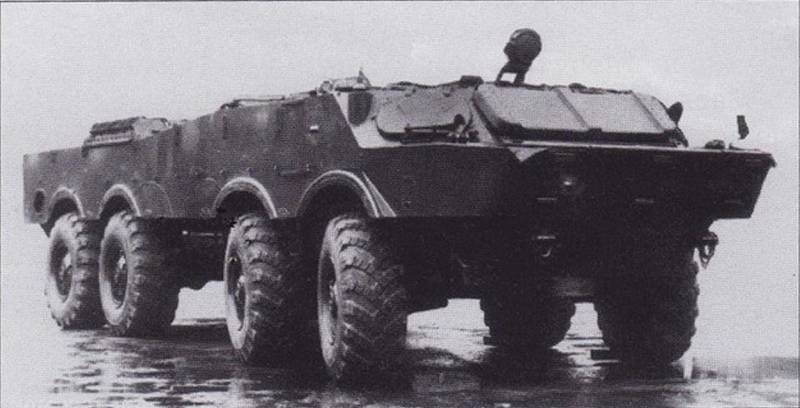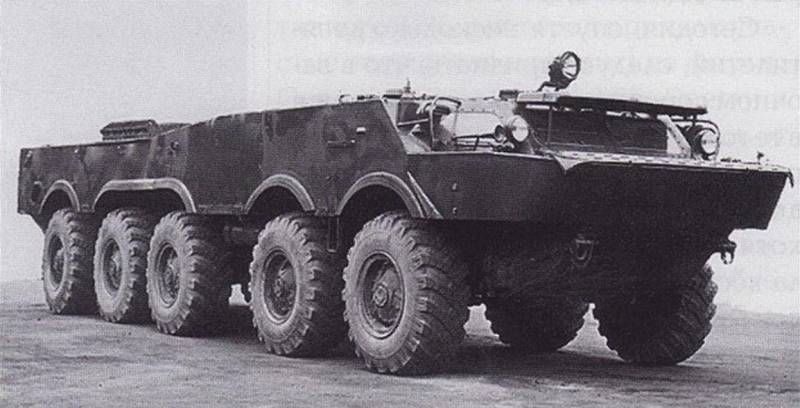Multipurpose wheel chassis "560 Object" and "560U Object"
Starting work on the creation of a promising universal chassis capable of carrying various equipment or weapons, was given in 1960 year. All leading organizations of the Soviet automobile and defense industry were attracted to the design of the new technology. So, Plant them. Likhachev launched the development of the project ZIL-153, the Gorky Automobile Plant continued the development of the product BTR-60, etc. Among other enterprises, an order for a new project was received by OKB-40 of Mytishchi Machine-Building Plant.
By this time, OKB-40 specialists had some experience in the field of military equipment, although they had not previously dealt with wheeled combat vehicles. Nonetheless, they set about completing the assignment and soon offered their own version of the multipurpose chassis. In accordance with the nomenclature that existed at that time, the MMP project received the working designation “560 Object”. Also in some sources, the chassis is referred to as MMZ-560. The result of the development of the original project was the appearance of the “560U Object”. Additional letters revealed the essence of refinement.
The project proposed the creation of a four-axle multi-purpose vehicle with a bearing armored body of a characteristic shape, providing the possibility of mounting various additional devices. It was proposed to use a relatively powerful diesel engine, coupled with hydro-mechanical transmission. The latter was responsible for issuing power to all drive wheels. The car had to move both by land, including difficult routes, and by water. The tasks were solved with the help of some original ideas, and due to this, the “560 Object” had a recognizable appearance.
The basis of the product "560" was a large bearing armored body, the appearance of which corresponded to the requirements as much as possible. It was planned to collect from armor plates of small thickness, providing protection only from bullets and fragments. In front of the case there was a manned compartment, which included the control compartment. The rear volume of this compartment was intended for the installation of special equipment and the installation of jobs for its operators. The hull feed was given under the engine and part of the auxiliary devices. Separate elements of hydromechanical transmission were located both in the stern of the hull and above its bottom.
The front of the hull, which formed a rather large overhang, was to be assembled from several armored parts of various shapes and sizes. The lower curved unit connected the forehead with the bottom. Above it was a curved part, placed with a slope forward. The upper parts were placed at different angles, giving the "560 Object" some similarity with other armored vehicles of its time. The top of the forehead had a trapezoid shape in plan and was made of three sheets with openings for glazing.
The hull sides were divided into two main parts. At the level of parts of the chassis, the hull had a smaller width in the presence of vertical sides. Above the wheels were located large and voluminous niches, due to which the overall width of the body increased. All along the car side were positioned vertically. A characteristic feature of the MMZ-560 project was the use of relatively low sides, which had small wheel arches on the bottom. In this case, the front half of the side was higher than the rear. Due to this, the roof consisted of two horizontal and one inclined section. In the center of the hull or above the stern, it was possible to mount this or that special equipment.
At the rear of the hull was a X-NUMX-cylinder V-shaped diesel engine D-12A. The engine mated with hydromechanical transmission. According to some data, the power plant and transmission for the “12 Object” were developed on the basis of assemblies and assemblies of the special tractor MAZ-560. By the beginning of the sixties, this machine was tested and demonstrated the high characteristics of the applied units. Existing or modified systems could be used in new projects.
The hydromechanical transmission was connected to the transfer case, with the help of which the power was distributed to all propulsion units. Cardan shafts transmitted torque to all four bridges of split and continuous construction, as well as a couple of feed water cannons. The shafts that fit the wheels were connected to the wheel gearboxes. The latter borrowed from the serial car ZIL-135.

The possible appearance of the missile complex "Hawk" on the chassis "560". Figure Militaryrussia.ru
In the basic version of the "Object 560" had an eight-wheel all-wheel drive chassis, built on bridges of different designs. Two front axles, equipped with steered wheels, had an independent suspension. Two rear axle differed continuous construction. Large diameter wheels connected to a centralized pressure control system.
To move on water universal chassis got a pair of water cannons. They were placed in the rear of the hull, on the sides of the engine. The intake openings were located on the bottom, and the water was discharged through the windows in the stern. Like other floating armored vehicles, MMZ-560 received a wave-reflector shield. In the stowed position, he lay on the frontal armor, in the worker - he was raised and installed with a slope forward.
In front of the case were placed jobs of the driver and the commander. They were asked to get inside the car after a couple of hatches in the roof. The project involved a marked improvement in visibility compared with a number of armored vehicles of the time. In the upper frontal parts provided a large opening with glazing. On the sides of it, in the sloping zygomatic sheets of the hull, there were two more windows that differed as much as possible. In a combat situation, all the windows were closed with movable armor covers. In this case, the driver and the commander could follow the road with the help of viewing instruments installed on their hatches in the roof.
The configuration of hatches and other devices on other frequent hulls should have been determined in accordance with the purpose of the chassis. At the same time, regardless of the type and tasks of the installed additional equipment, the machine had to have hatches for landing operators or for servicing the internal equipment. Their placement depended on the installation features of internal and external devices.
In terms of its dimensions, the 560 Object was little different from other wheeled chassis that were being developed at the same time as it. The total length of the machine did not exceed 7-7,5 m, the width was of the order of 2,5-3 m, the height of the roof of the case was slightly more than 2 m. Depending on the composition and configuration of the special equipment, the total weight of the machine could reach 15-16 t. At the same time, the designers hoped to get high performance. The maximum speed on the highway could reach 70-80 km / h, on the water - 8-10 km / h. The wheeled chassis could provide high throughput in all landscapes.
The development of technical documentation for the 560 project continued until 1961-62, after which Mytishchi machine-building plant began assembling a prototype. In the course of the first checks, the driving performance of the car on different roads and areas was studied. It was found that the chassis, in spite of various minor flaws, generally meets the requirements and can be used as a base for special or military equipment.
Already at this stage an approximate range of modifications of the “560 Object” was determined. This chassis could become a base for several missile systems of various purposes at once. It was proposed to mount electronic equipment and launchers of the Ellips / Osa or Krug anti-aircraft missiles. Also MMZ-560 could become the carrier of the Yastreb tactical missile. In all cases, weapons control should have been installed inside the hull, and it was planned to place antenna posts or launch guides on the roof.

Tests of the “560 Object” with weight simulators of the equipment of the “Hawk” complex. Shot from the d / f "Cars in uniform", dir. And Kryukovsky, studio "Wings of Russia"
For example, in the “Hawk” project, the front part of the roof, above the second axis, was intended for mounting its own radar station. In the stern it was planned to install a lifting starting guide. In addition, in the central gap between the wheels and in the stern of the hull hydraulic jacks were to appear to level before firing.
"The 560 object" as a carrier of the "Hawk" interested the customer, which led to the start of the relevant tests. A weight simulator of the antenna device appeared on the roof of the case. Also, the ballast could be installed inside the case. In this configuration, the chassis passed new tests and showed its potential. However, this work actually stopped. In the mid-sixties, the military decided to close the “Hawk” project. The Fakel MCB, which developed it, was supposed to transfer all the materials to the Kolomna Mechanical Engineering Design Bureau. On the basis of the existing developments, the 9K79 “Tochka” complex was soon created, but a new multi-wheeled chassis was used in this project.
Unfortunately, the “560 Object” chassis could not become the carrier of the future Osa complex. At the stage of comparing several promising machines, it was found that it loses to competitors in terms of capacity. In addition, it could hardly cope with the equipment of the complex, which by this time was noticeably heavier and went beyond the calculated limits. The winner of the comparison was the special chassis “Object 1040” developed by the Kutaisi Automobile Plant. It was this car that was soon equipped with the necessary devices and attracted the entire air defense system to the tests.
However, OKB-40 MMZ did not stop work on its chassis. The designers took into account the customer's claims and reworked the existing project. Now the military planned to submit "Object 560U." The new letter meant “elongated” and indicated the modified design of the hull.
To improve the performance characteristics of the upgraded chassis received an additional axis. Rigid axle, additional transmission mechanisms, etc. installed on the new housing section. The latter was literally inserted between the third and fourth axes of the base machine. At the same time, the third and fourth wheels of each side were now placed under a common wing. This refinement led to a known increase in the size and curb weight of the chassis. At the same time, the available volumes and areas for the installation of special equipment have increased. Grew and load capacity.
It should be noted that the multi-purpose chassis "Object 560U" was the first domestic machine with a wheel formula 10х10. Before him, such machines were not developed or built. Subsequently, this direction was developed, as a result of which the army received a whole set of “long” samples with a large number of axes.
In 1963, an experienced 560U Object was released for testing. Whether this car was built from scratch or was converted from the existing prototype is unknown. There is no exact information on this subject, as well as unknown photos of the two cars. However, the methods of manufacturing a new prototype could hardly have an impact on the future fate of the project.
According to known data, MMZ-560U was again proposed to be used as a base for the Osa anti-aircraft complex. But the improved machine did not suit the customer. After completion, it complied with the requirements of the air defense system in terms of capacity, and also had some reserve in case of further increase in the mass of the equipment. However, along with the load-carrying capacity, the weight of the car also increased. Its curb weight exceeded 19 t, which could not suit the customer.
In accordance with the terms of reference, the Osa complex should have been able to be airlifted using the An-12 military transport aircraft. The latter could lift a cargo of up to 20 tons. When drafting the requirements for Oce, the military limited its maximum weight to 19 tons, creating a certain margin. The anti-aircraft missile system on the five-axis chassis did not fit these requirements and therefore could not receive approval.
Apparently, after the refusal of the Osa project, the 560U multipurpose chassis was left without a future. In theory, it could be used as a carrier of various technical means, but in all cases there was a risk of going beyond the permissible limits by weight. Thus, any new model of equipment based on the “560U Object” risked repeating the fate of the failed version of “Wasps”.
After the second failure with the search for suitable special equipment, the project MMP-560 / 560U was closed. With all its advantages, such a chassis in the existing situation had no real prospects. In addition, there were several more successful wheeled armored vehicles capable of fully performing the functions of equipment or weapons carriers. The project did not begin to recycle a second time and simply closed.
A prototype (or samples) of the “560 Object” after completion of the tests could be sent for disassembly. Unlike a number of other interesting cars of the time, this technique has not been preserved. Now both experienced machines can be seen only in a few preserved photographs. In addition, filming with the test machine as a carrier of a tactical missile is known.
The development program of promising wheeled chassis, capable of carrying this or that equipment or armament, meant from the very beginning that some samples would go into a series, while others would not leave the testing stage. This is what happened. New models of military and special equipment began to be built on the basis of the most successful chassis, but they refused from the “560 Object” and “560U Object”. As far as is known, the OKB-40 of the Mytishchi machine-building plant did not develop military wheeled vehicles after that.
Based on:
https://kolesa.ru/
http://denisovets.ru/
http://militaryparitet.com/
https://strangernn.livejournal.com/
http://militaryrussia.ru/blog/topic-260.html
Korovin V. The Osa anti-aircraft missile system. // Technique and weapons, 2010. No.7.
Solyankin A. G., Pavlov M. V., Pavlov I. V., Zheltov I. G. Domestic armored vehicles. XX century. - M .: Exprint, 2010. - T. 3. 1946 – 1965.


Information